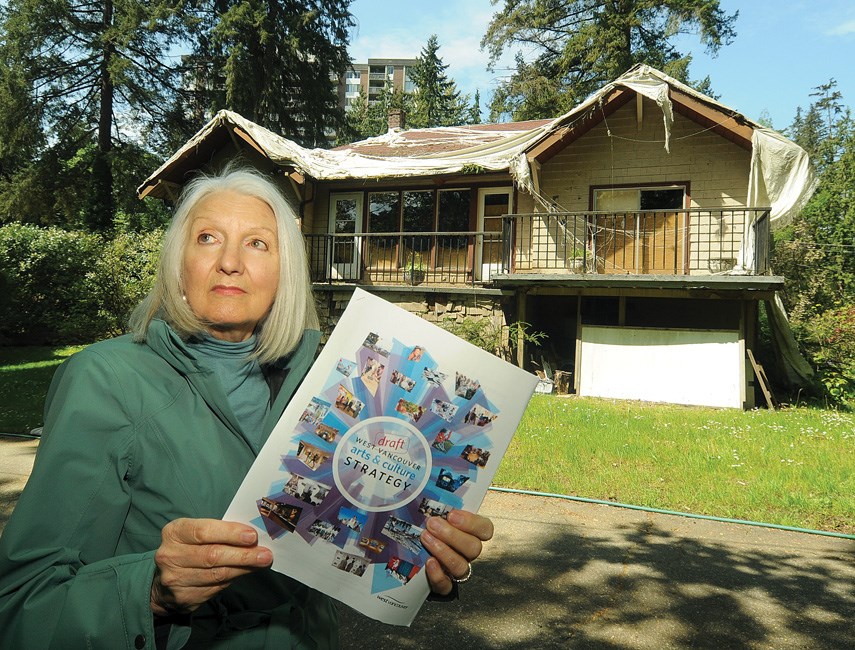Members of West Vancouver’s arts community are taking the municipality to task for letting the Klee Wyck property fall into ruin.
The land bordering the Capilano River off Keith Road was bequeathed to the district in 1960 by Dr. Ethlyn Trapp, a prominent physician, humanitarian, pioneer in cancer research, and patron of the arts. She named the property Klee Wyck in honour of the Haida name bestowed on her personal friend Emily Carr.
The legal agreement signed by the reeve in 1960 stated the district “agrees at all times after the death of the owner to develop, keep, maintain and use the said lands for any one or more of park, nursery garden, playground or other purpose of public recreation and for no other purpose.” And for years the 1925 home and its outbuildings were used for arts programming of all kinds.
Said arts advocate Ingunn Kemble, “There was everything you could possibly think of – art classes, the workshops, the parties, the weddings. It was busy all the time and it was creating revenue. And it could have created more revenue had they bothered, when the roof started leaking, to fix the holes in the roof.
“At some point a conscious or unconscious decision was made to just let it rot,” said Kemble.
Today, the house on the estate property is dilapidated. Tarps that had been thrown over the roof to prevent water damage are themselves disintegrating and strewn about like spider webs. On the front door above the condemned steps, there is still a decal that reads “West Vancouver Arts Council.” During a visit to the site by the North Shore News on Friday, someone had parked a camper van on the property and was plugged into Klee Wyck’s electricity via an extension cord.
Kemble said the decay at Klee Wyck is typical of West Vancouver’s arts facilities.
“Why has the richest municipality – certainly in B.C. or in the Lower Mainland – never taken care of its buildings? The Ferry Building is rotting out on one side. The Museum has been leaking on the north side for years and it’s now all mouldy,” she said.
By coincidence, the law firm that oversaw Trapp’s bequeathment was Douglas, Symes & Brissenden. Founding partner Pearly Brissenden also bequeathed his West Vancouver property to the municipality on the promise that it would become a park. The district never followed through and today, West Vancouver council has applied to the courts for permission to vary the legal trust and sell the land to acquire more waterfront property in Ambleside for public use.
“If you ever consider donating a piece of property to West Vancouver for a specified purpose, don’t do it,” Kemble said.
District spokeswoman Donna Powers admitted the district had been letting things slide with its infrastructure of all kinds.
“In the past, all district facilities, not just Klee Wyck – I hate to say it – were almost completely neglected in terms of life cycle maintenance. There was no plan for maintenance of district facilities and Klee Wyck was one of those that was impacted,” she said.
In 2015, however, the district did a complete survey of its assets, including their lifespan estimates and costs for replacement. Council’s budgets since have included an asset levy to shore up maintenance and replacement of the district’s aging assets.
“It’s unfortunate but that’s the current state. It won’t happen any more because that has been rectified through the asset levy,” Powers said.
District staff are also looking into whether or not the municipality should even accept bequeathments of land when there are stipulations attached, Powers added.
“It is an awkward situation when someone donates land to the district with terms around it because it does become quite a burden on the taxpayer to maintain it to the terms of the trust,” she said. “That goes both ways. … It can be more of a burden than a benefit.”
As for what will come of the property, that’s something still under study by district staff, Powers said. It’s not known whether the home can be salvaged, or what would be legally allowable on the Klee Wyck land without having the trust varied. Some of those questions will be answered following council’s adoption of an arts and culture strategy, she added.
“We’ve done a lot of work in the last two years to bring everybody to the table. There is going to be an arts and culture strategy with the input of all of those groups presented to council in June,” she said.
One of the items included in the Ambleside waterfront plan is a theoretical new arts facility, Powers noted.
Kemble, who has been included in the formation of the arts strategy, is holding out little hope.
“It’s just a survey. It’s not a strategy. There have been a number of meetings and everybody is very angry about it,” she said.
In the meantime, Peggy Stortz, who used to run the popular Dramaworks program at Klee Wyck is hoping to see the arts return to the idyllic setting.
“It was an absolutely magical, beautiful, perfect place to be,” she said. “I think perhaps not everyone sees the value in beauty and in antiquity. I think Klee Wyck kind of got lost in the shuffle because it wasn’t big and it wasn’t shiny. It was a dear little place tucked away on the riverbank. … I’d love to see it somehow restored. I’d love to see children running in the garden. I’d love to see music being played there and art being created, workshops. It’s such an inspirational place to be in.”



